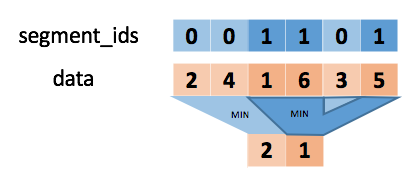mindspore.ops.unsorted_segment_min
- mindspore.ops.unsorted_segment_min(x, segment_ids, num_segments)[source]
Computes the minimum of a tensor along segments.
The following figure shows the calculation process of unsorted_segment_min:
 \[\text { output }_i=\text{min}_{j \ldots} \text { data }[j \ldots]\]
\[\text { output }_i=\text{min}_{j \ldots} \text { data }[j \ldots]\]where \(min\) over tuples \(j...\) such that \(segment\_ids[j...] == i\).
Note
If the segment_id i is absent in the segment_ids, then output[i] will be filled with the maximum value of the x’s type.
The segment_ids must be non-negative tensor.
- Parameters
x (Tensor) – The shape is \((x_1, x_2, ..., x_R)\). With float16, float32 or int32 data type.
segment_ids (Tensor) – TThe label indicates the segment to which each element belongs. Set the shape as \((x_1, x_2, ..., x_N)\), where 0 < N <= R.
num_segments (Union[int, Tensor], optional) – Set \(z\) as num_segments, it can be an int or 0-D Tensor.
- Returns
Tensor, the shape is \((z, x_{N+1}, ..., x_R)\).
- Raises
TypeError – If num_segments is not an int.
- Supported Platforms:
AscendGPUCPU
Examples
>>> from mindspore import Tensor >>> from mindspore import ops >>> import numpy as np >>> x = Tensor(np.array([[1, 2, 3], [4, 5, 6], [4, 2, 1]]).astype(np.float32)) >>> segment_ids = Tensor(np.array([0, 1, 1]).astype(np.int32)) >>> num_segments = 2 >>> output = ops.unsorted_segment_min(x, segment_ids, num_segments) >>> print(output) [[1. 2. 3.] [4. 2. 1.]]